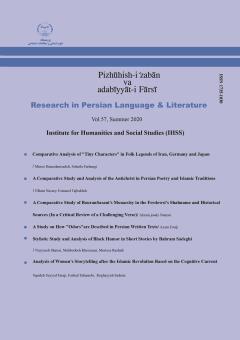-
-
List of Articles
-
Open Access Article
1 - Comparative Analysis of "Tiny Characters" in Folk Legends of Iran, Germany and Japan
minoo hamedanizadeh soheila farhangi -
Open Access Article
2 - A Comparative Study and Analysis of the Antichrist in Persian Poetry and Islamic Traditions
Elham Nazary Esmail Tajbakhsh -
Open Access Article
3 - A Comparative Study of Bouransasani’s Monarchy in The Ferdowsi’s Shahname and Historical Sources (in a Critical Review of a Challenging Verse)
Akram Joudi Nemati -
Open Access Article
4 - A Study on How "Odors"are Descibed in Persian Written Texts
azam estaji -
Open Access Article
5 - Stylistic Study and Analysis of Black Humor in Short Stories by Bahram Sadeghi
nayereh shateri mahboobeh khorasani morteza rashidi -
Open Access Article
6 - Analysis of Women's Storytelling after the Islamic Revolution Based on the Cognitive Current
sepideh seyyed faraji Farhad Tahmasbi Ruqayyah Sadraie
-
The rights to this website are owned by the Raimag Press Management System.
Copyright © 2017-2025







